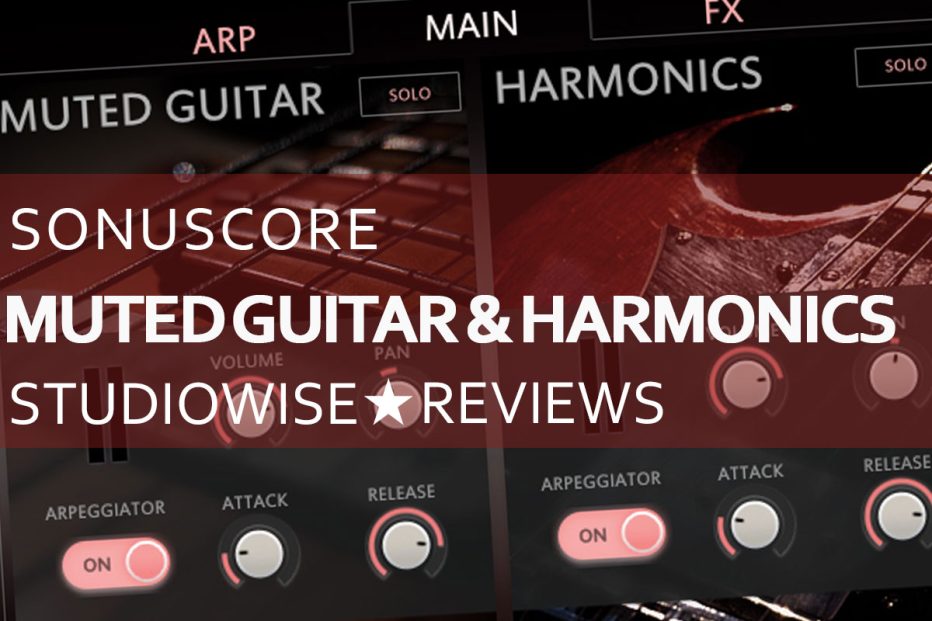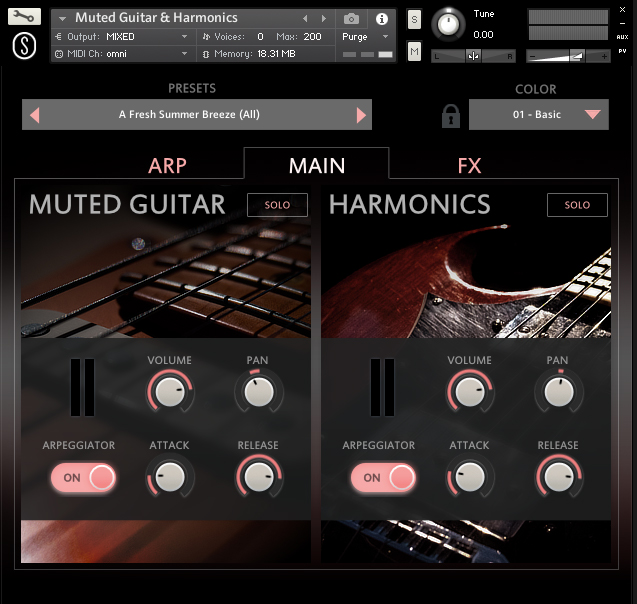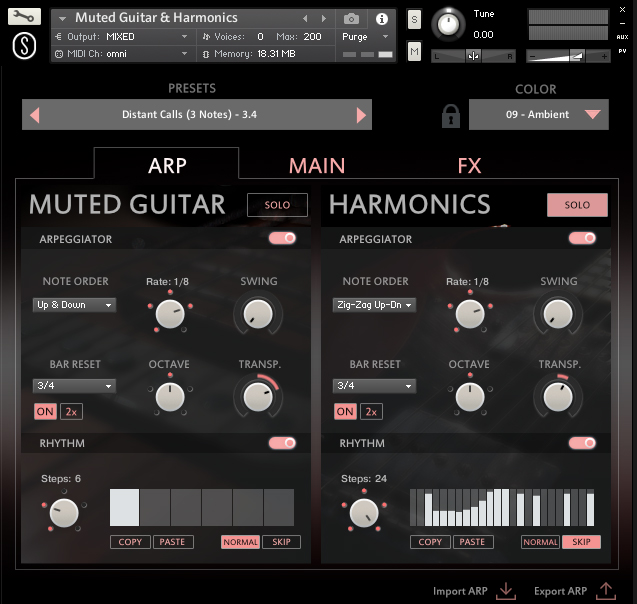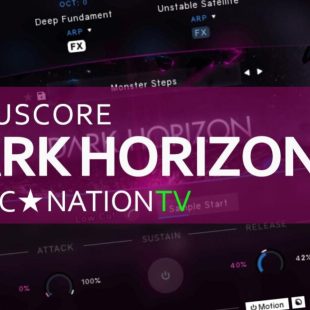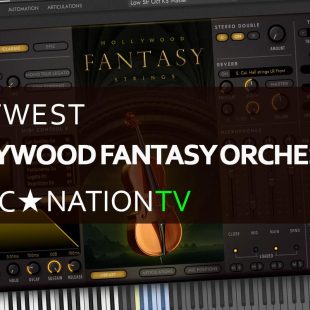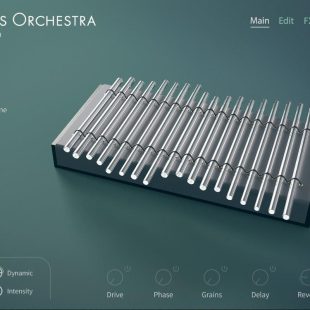SONUSCORE ORIGIN SERIES: MUTED GUITAR AND HARMONICS
Welcome to our review of Sonuscore’s latest addition to their excellent Origins series. It will be difficult to shine much more light on what we have covered in-depth in previous reviews, but I’m excited to hear what this new element can bring to the game and hopefully expand the capabilities of the collective.
Overview
Muted Guitar and Harmonics is a Kontakt-based sample library requiring the full professional version of the Native Instruments core system to run.
The library features two sampled electric guitars with different tonal characteristics to supply the contrasting offset arpeggiated style that the series is well known for. A Fender Stratocaster provides the rhythmic sounds while a Gibson SG creates the shimmering harmonic elements.
The library downloads to a paltry 170MB (yes, megabytes! Which is rare in these days of mega-gigabyte sample monster libraries.) The system requirements are equally meagre – any modern PC or Mac with 4GB of RAM or more.
We have covered two other libraries in the Origin series from Sonuscore so I will not go over the material covered in those reviews. I suggest that if you are considering buying for the first time, you might read these reviews for a more in-depth working critique of the core software. Muted Guitar and Harmonics use the same Multi-Arpeggio Designer system and to all intents work the same.
STRING AND BALALAIKA:
https://www.musicnation.co.nz/sonuscore-origins-vol3-12-string-and-balalaika/
STEEL TONGUE AND SANSULA, AND MUSIC BOX AND PLUCKED PIANO:
https://www.musicnation.co.nz/sonuscore-origins-1-and-2/
I would like to cover my thoughts on the sound and application usage of the library, as the series so far with is properly the most ambiguous.
Playthrough
Unlike previous libraries in the range, Muted Guitar and Harmonics is essentially the same instrument type presented as split elements. Other libraries, like the 12 String and Balalaika, Steeltongue and Sansula, and Music Box and Piano all offer very contrasting instruments.
Being the most subtle of the range, this library feels a little lacklustre on the first play-through. While some quite nice results can be achieved with it as a solo instrument, for me Muted Guitar and Harmonics work best when used in conjunction with the others in the series as layers.
The tone is quite unusual, at least for a guitar. The library features the same duel-engine Multi-Arpeggiator Designer system that allows two separate sampled instruments to play together as either playable instruments or sequenced arpeggiators. The bell-like tone of the first sample engine is reminiscent of a Stratocaster but with a much stronger percussive attack. The sound suggests that the guitar strings are being hit with mallets rather than plucked. I do quite like the tone, but it is not what I expected.
The ‘Color’ presets vastly affect the tone, so some experimentation is required here on all patches. In ‘INIT’ state the guitar sounds almost like its real-world counterpart, but it still has a distinctive character.
The second sample engine plays back the Gibson SG performing harmonic notes. This in itself is a little strange, as personally, I would have thought the Gibson would fare better as the rhythm element with the Strat providing the bell-like harmonics. But this is the way it is.
Again, the sound is very percussive. I can understand the reasoning behind this: the harmonics element helps to excite the reverb effect which no doubt works better with a more punchy sound. The included attack and release controls work really well to provide flexible variations from very percussive thought to almost pad-like results.
Getting Experimental
Naturally, the first thing I had to try was running the instrument through a guitar amp simulator. Though the basic Konkakt effects are fine, I found using something like AmpliTube really works well.
Of course, this is not the instrument to use for Joe Satriani-type shred solos, but a surprisingly good level of playability is here, though somewhat limited in range. I can definitely see some imaginative uses for this on a project as a solo instrument. The very percussive nature makes amplification very twitchy and prone to overdriving, which sounds great.
Similar to feeding a piano into a guitar amp, the distortion adds a nice level of breakup and intensity to the sound. I quite enjoyed experimenting with other forms of traditional ‘outboard’ gear, like foot pedals and modulation effects as well.
Fun with friends
Muted Guitar and Harmonics is quite restrained in comparison to the others in the series. It could be considered the boring one of the group, but I think this lends it to be more foundational when layering, which is without a doubt the way to use it.
It’s not as ethereal or atmospheric as the others, but when layered makes everything sound more grounded, doing a great job of tying everything together. Sometimes it is easy to make layered patches sound too cluttered and busy when the instruments primarily work off randomisation patterns. Something a bit more organic like this settles everything down, drawing the focus in and allowing more melodic details to shine through.
I found if you carve a little low-end with the EQ, Mute Guitars and Harmonics pops through nicely allowing space for the other layers to provide more of the shimmering top end.
Conclusion
I feel this product could have offered more flexibility with a contrasting secondary element, the two guitars are similar enough that as a solo instrument, Muted Guitar and Harmonics is underwhelming.
However, there is a positive upside in that this library sounds rather good as a foundation texture due to its more recognisable tone. I found this library a great starting point for layering others in the range because it’s not as flamboyant as its fellow stablemates in the Origin series. Rather it plays an important role as the ‘sensible’ one of the bunch.
Sometimes you don’t need epic – you just need simple.
For full details and purchasing options are over on Sonuscores website www.sonuscore.com
This is a good addition to your collection. If you are new to the Origin Series, I highly recommend you partner this with one or more other titles at checkout or perhaps look to the new excellent value Vol 1-5 bundle recently released.

Like the review? Shout us a cup of coffee!

